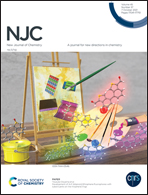Boron-doped and serine and histidine-functionalized graphene quantum dots with strong yellow fluorescence emissions for highly sensitive detection of carbofuran in cucumber and cabbage†
Abstract
The weak fluorescence of graphene quantum dots upon visible-light excitation limits their applications. The paper reports the synthesis of boron-doped and serine and histidine-functionalized graphene quantum dots (B–Ser–His-GQDs). The resulting B–Ser–His-GQD shows the strongest yellow fluorescence emission upon visible-light excitation at 485 nm. The fluorescence intensity is more than five-fold that of the maximum blue fluorescence emission produced by ultraviolet light excitation at 360 nm. The B–Ser–His-GQD was used as an optical probe for fluorescence detection of carbofuran. In the absence of carbofuran, the B–Ser–His-GQD is strongly adsorbed onto Ti3C2 nanosheets, resulting in rapid fluorescence quenching via fluorescence resonance energy transfer. In the presence of carbofuran, the target binds with carbofuran aptamer DNA/assist duplex strand DNA to produce target-based trigger DNA/carbofuran composites, which triggers DNA cycling and forms Y-shaped double-stranded DNA. The formed Y-shaped DNA cannot be adsorbed onto the Ti3C2 nanosheet, indicating strong fluorescence emission of B–Ser–His-GQDs. By the DNA cycling, one target molecule results in the formation of many Y-shaped DNA molecules and realizes significant signal amplification. The peak fluorescence intensity increases linearly with the increase in carbofuran concentration in the range of 1.0 × 10−13–1.0 × 10−7 M with a detection limit of 3.4 × 10−14 M. The sensitivity is more than that in all reported methods for the detection of carbofuran. The proposed analytical method was successfully applied in the fluorescence detection of carbofuran in cucumber and cabbage.



 Please wait while we load your content...
Please wait while we load your content...